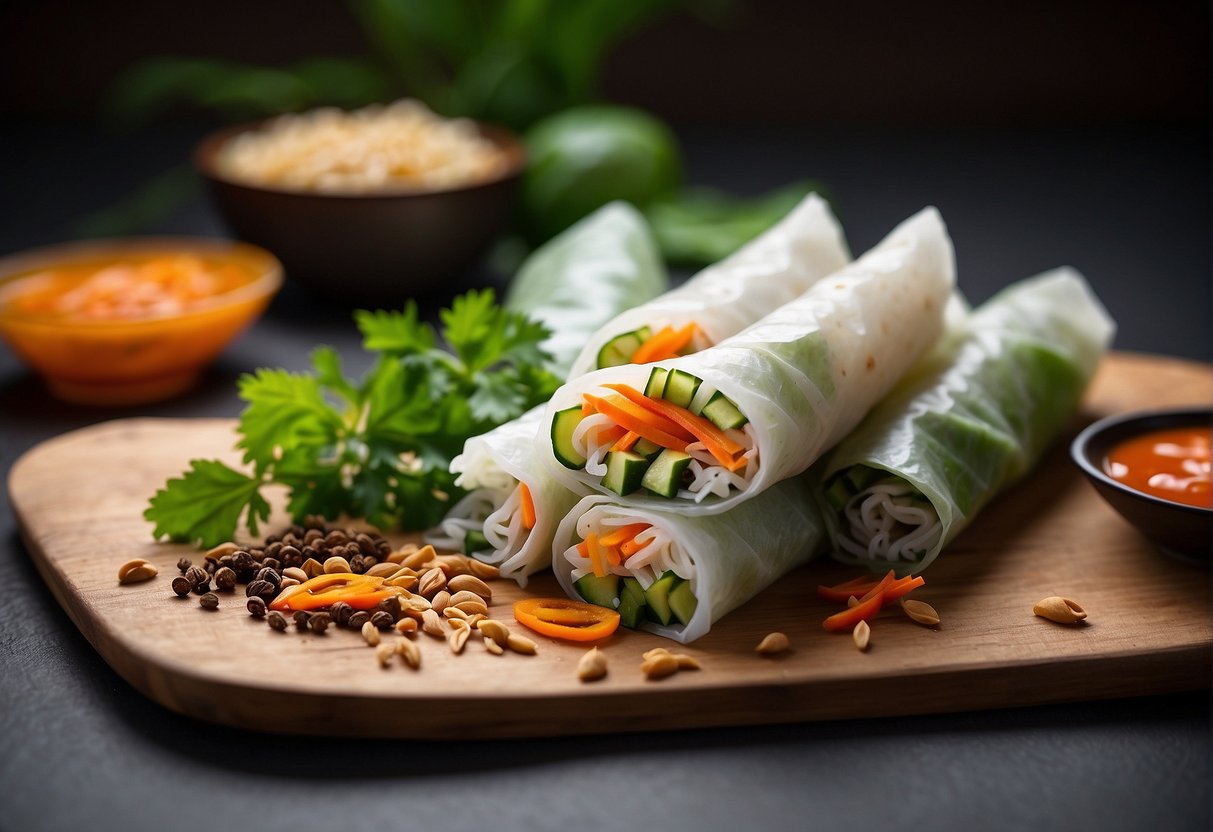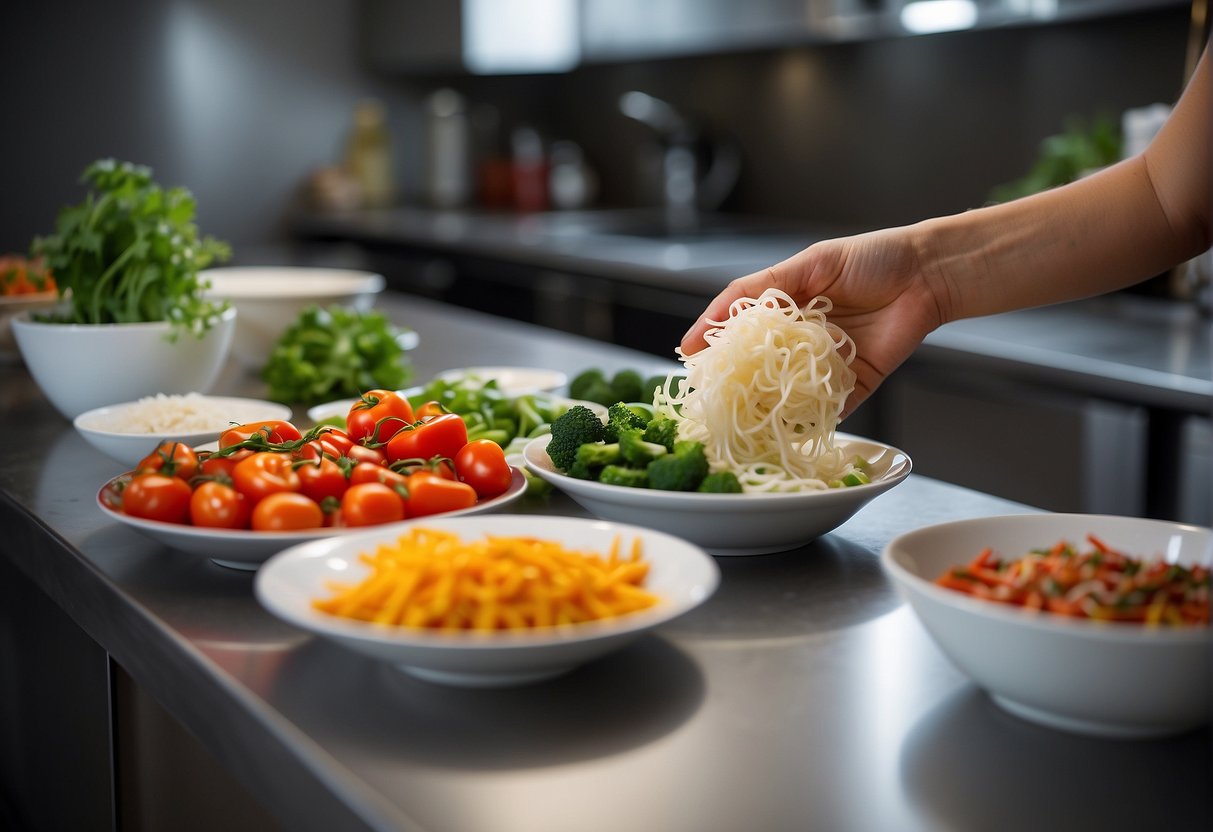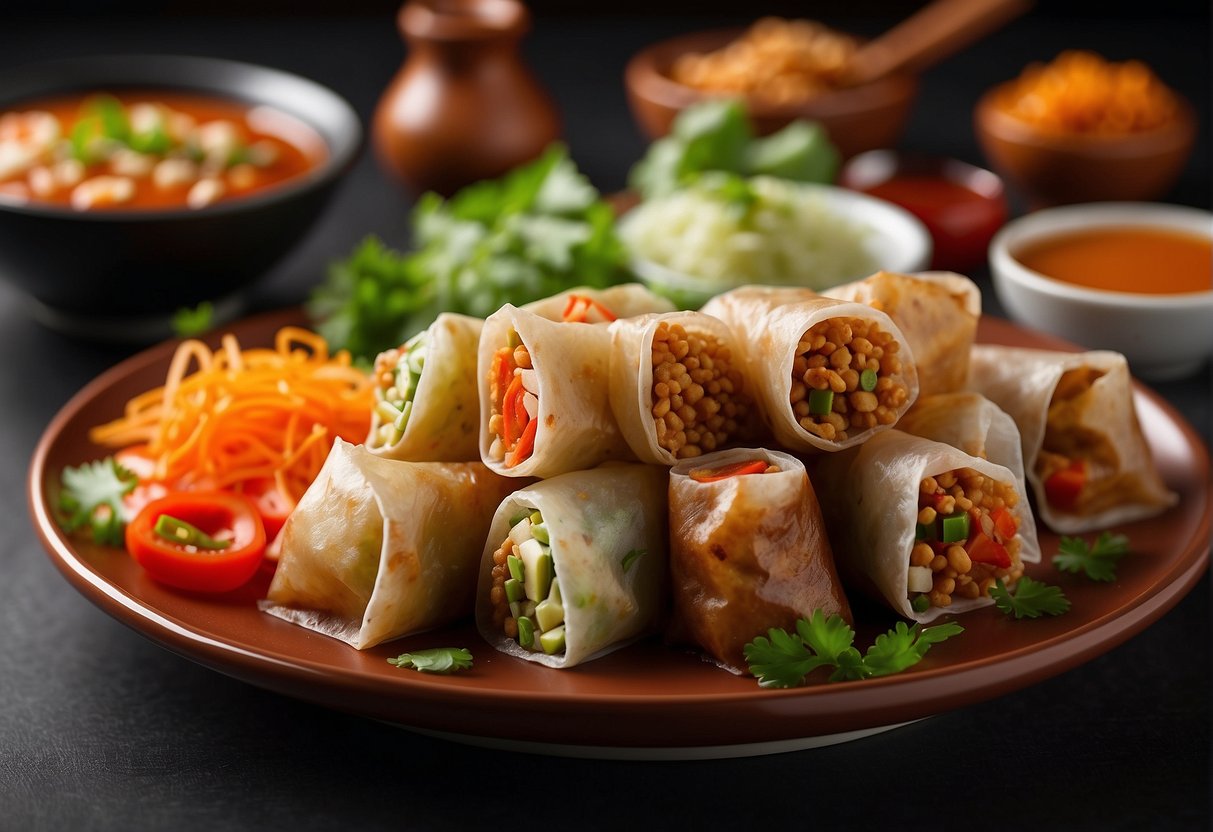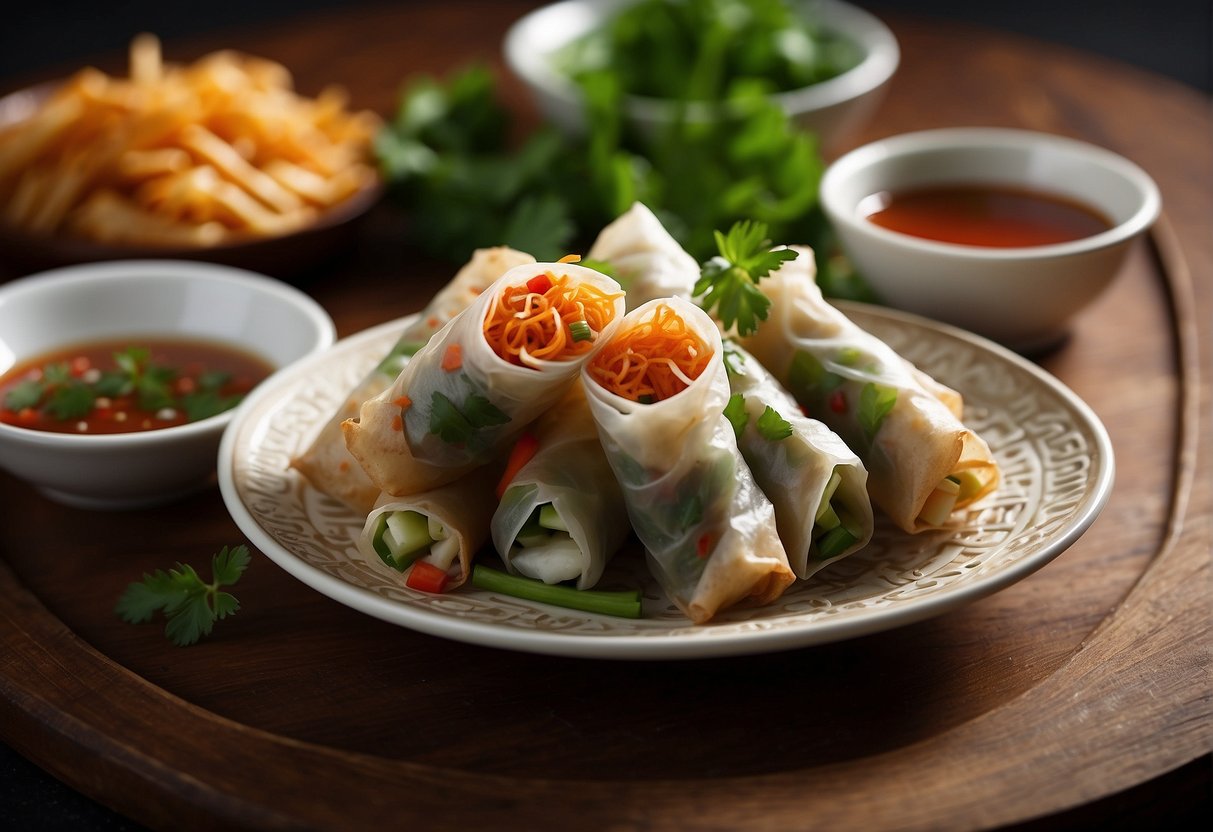Spicy noodle spring rolls offer a scrumptious twist on a classic Asian cuisine staple. Blending the heat of spicy noodles with the fresh, crisp exterior of a spring roll creates a unique culinary experience. For lovers of heat and texture, this dish takes inspiration from popular Korean fire noodles, known for their intense spice level and depth of flavor. The main ingredient, which is often a combination of rice noodles or wheat noodles coated in a spicy sauce, is versatile enough to be customized to any palate while remaining central to the dish’s identity.

Creating spicy noodle spring rolls at home is simpler than one might expect. My personal approach marries the bold flavors of Asian spices with the craft of rolling the perfect spring roll. While traditional spring rolls are often filled with vegetables and proteins, the addition of spicy noodles transforms them into a heartier meal. My recipe begins with preparing the noodles to the perfect level of spiciness before wrapping them in rice paper alongside a selection of fresh vegetables for balance and crunch.
The process of crafting these spring rolls is as engaging as it is rewarding. From soaking the rice paper to the right consistency to the filling placement and the rolling technique, each step is crucial to achieving the ideal roll. Achieving a snug, secure wrap ensures every bite carries the perfect ratio of noodle to crunch. And the result? A dish that’s not just flavorful but also a feast for the eyes.
Choosing the Right Ingredients

When preparing spicy noodle spring rolls, I always emphasize the quality and variety of ingredients to ensure my rolls are packed with flavor and texture. Starting with the spicy noodles, choosing the right type is crucial. I opt for rice noodles, which are thin and delicate, perfect for absorbing the bold spices and sauces I’ll use to create that irresistible heat.
For rice paper wrappers, I go for high-quality, flexible ones. They need to be durable enough to hold all the ingredients without tearing, yet soft enough to bite through easily. It’s key to handle them with care, keeping them moist but not overly wet, as they can become difficult to work with if too soggy.
When it comes to vegetables, my choice of fresh veggies like carrots, bell peppers, and cucumbers adds crunch and freshness, while green onions provide a mild, aromatic kick that complements the spicy noodles beautifully. Preparing veggies by thinly slicing them ensures even distribution within each roll.
| Ingredient | Why I Choose It |
|---|---|
| Spicy Rice Noodles | Absorb flavors; texture |
| Rice Paper Wrappers | Durable, yet soft |
| Fresh Veggies | Crunch and freshness |
| Green Onions | Mild, aromatic flavor |
Lastly, a splash of sesame oil in the filling or as part of a dipping sauce brings a nutty essence that rounds out the dish. Its unique taste binds the other ingredients together, creating a harmonious blend of savory, spicy, and fresh notes in every bite.
Preparing the Noodles
Boiling Noodles
When I make spicy noodle spring rolls, my first step is to properly boil the noodles. Using a large pot of hot water, I make sure to bring the water to a rolling boil before adding my noodles. For this recipe, I often use Buldak Hot Chicken Flavor Ramen for its distinct heat. I carefully place the noodles into the pot and let them cook until they’re just tender but still have a bit of chew—al dente is what I aim for.
Seasoning and Flavor
Once the noodles have cooked, it’s time to season them. I whisk together a mixture of Samyang sauces for heat, soy sauce for umami, and sesame oil for richness. This creates a deeply flavorful and spicy coating for the noodles. I then add this mixture to the drained noodles while they’re still warm, ensuring they absorb the flavors fully. For added taste and texture, I toss in chopped green onions and sometimes a homemade spicy peanut sauce to complement the overall spice level.
Cooling and Setting Aside
Finally, I cool the noodles under a stream of cold water to stop the cooking process and to set the flavors. This also helps in keeping the noodles from sticking together. Once cooled, I transfer them to an airtight container and let them rest. This could be in the fridge if I’m preparing them for the next day, or at room temperature if they’re to be used shortly. Allowing them to sit ensures that every strand of the noodle is infused with the spicy and savory notes that are characteristic of this dish.
Creating the Perfect Wraps

In my experience, the secret to delicious spicy noodle spring rolls lies in mastering the wraps. A well-constructed wrap holds the filling snugly and fries up to a delectable golden brown.
Handling Rice Paper
Handling rice paper requires patience and care. Before anything else, fill a large, shallow dish with lukewarm water. I gently submerge one rice paper wrapper at a time for about 10 seconds until it’s pliable but not overly soft. It’s important to have a clean, dry surface ready to lay the wet rice paper on, and I always keep a wet paper towel on hand to prevent the wrappers from drying out.
Filling Distribution
I’ve found that the perfect amount of noodles is crucial to avoid overstuffing. For each wrap, I aim to place a generous yet controlled amount of noodles at the bottom portion of the wrapper. Adding complementary textures, like sliced carrots and fresh mint leaves, in proportionate amounts ensures each bite is balanced and flavorful.
Rolling Technique
I start rolling by folding the bottom portion of the wrapper over the filling, tucking in the right side and left side to secure the contents. The trick is to keep the wrapper tight around the filling without tearing the delicate rice paper. I leave about an inch of the paper at the top to seal the roll, which helps to lock everything in place.
Frying to Golden Perfection
Frying spring rolls to achieve that desirable golden brown color and crisp texture is all about temperature control. I heat oil in a pan to medium-high heat, usually around 350-375°F. I carefully place the rolls seam side down, using a pair of tongs, and fry until they are golden brown, turning occasionally. Post-frying, I rest them on paper towels to remove excess oil.
Dipping Sauces and Flavor Enhancers

To elevate the flavor of spicy noodle spring rolls, a delectable dipping sauce can be the perfect accompaniment. I focus on diversifying taste experiences through these sauces, highlighting the importance of balancing flavors to suit various preferences.
Traditional Vietnamese Dips
In the realm of Vietnamese cuisine, peanut butter often serves as a cornerstone for their iconic dipping sauces. For a classic taste, I recommend a spicy peanut sauce that combines smooth peanut butter with a hint of lime juice for tartness, a sweet element like maple syrup, and a kick of heat to match the spicy level of the spring rolls. Garnish with sesame seeds for an added crunch.
- Ingredients: Peanut butter, lime juice, maple syrup, chili flakes
- Garnish: Toasted sesame seeds
Korean-Inspired Spicy Sauce
Korean flavors inspire a more intense heat profile. My version of a Korean-Inspired Spicy Sauce borrows elements from the popular Korean fire noodles. This sauce combines chili lime sauce with a sweetener like maple syrup to balance the heat, offering your taste buds a thrilling ride.
- Ingredients: Gochujang (Korean chili paste), chili lime sauce, maple syrup
- Description: Rich, fiery with a balanced sweet note
Customization Tips
Customizing your dipping sauce is an opportunity to cater to personal taste preferences. If you desire a more robust nutty flavor, increase the proportion of peanut butter. For a tangier zest, add more lime juice. Adjusting the amount of added spices can dial up or down the spicy level, while incorporating sesame seeds can provide a subtle texture contrast.
- To Adjust Nuttiness: Add more peanut butter
- For Tanginess: Increase lime juice
- Spice Adjustment: Vary chili powder or flakes
- Texture Addition: Sprinkle sesame seeds
Presentation and Serving

When I serve spicy noodle spring rolls, I pay close attention to the aesthetic appeal because we eat with our eyes first. My aim is to make the dish as visually exciting as it is flavorful.
Plating Techniques
I start with a large bowl and gently place my spring rolls after they are crafted to perfection, ensuring they don’t touch and stay intact. For a meal, I like to arrange them on a platter, slightly overlapping for a bountiful look. When using an airtight container for storage, I layer them with parchment paper to keep them fresh and prevent sticking. As I transfer the rolls to the serving platter, I ensure the cut side faces up, showcasing the vibrant colors of the fresh veggies nestled inside.
Garnishing for Elegance
To elevate the presentation, I sprinkle a handful of sesame seeds and finely chopped green onions over the spring rolls to add a burst of texture and color. A drizzle of sesame oil gives an inviting sheen and enhances the flavor profile. I often garnish with a few mint leaves placed strategically on the plate or tucked into the spring rolls themselves for a hint of freshness with each bite.
Storing and Reheating
When I make spicy noodle spring rolls, ensuring they remain delicious for future meals is just as important as the initial preparation. Proper storage techniques prevent sogginess, while the right reheating methods maintain the spring rolls’ crispness.
Proper Storage Methods
To store any leftover spicy noodle spring rolls, I first let them cool to room temperature. I avoid adding extra water or leaving them out for too long to prevent a mushy texture. Once cooled, I wrap the spring rolls individually in plastic wrap, which helps maintain their shape and freshness. Then, I place the wrapped rolls in an airtight container and refrigerate them. This method helps keep the rolls fresh for 2-3 days.
Reheating Without Soggy Wraps
I’ve found that the best way to reheat spicy noodle spring rolls is in a skillet over medium-high heat. This approach helps the wraps regain their crispness without becoming soggy. Here’s my process:
- Preheat the Skillet: I set a non-stick skillet over medium-high heat to warm.
- Unwrap: I remove the plastic wrap from the spring rolls.
- Reheat: I place the spring rolls in the skillet, ensuring they’re not touching. I heat them for 10-15 seconds on each side. Keeping a close eye on them is key to prevent burning.
- Serve: Once the wraps are crispy and heated through, I take them off the heat and serve immediately.
Using this method, I ensure my spicy noodle spring rolls are just as satisfying as when they were freshly made.
Nutritional Information
When creating my spicy noodle spring rolls, I carefully consider their nutritional content. The calorie count typically depends on the ingredients chosen for both the filling and the dip. Usually, one serving of these spring rolls contains approximately 150 calories, though this can vary with different recipes and portion sizes.
Below is a list of common ingredients and their estimated caloric and dietary impact:
- Spicy noodles: Depending on the brand, 200g can range from 200 to 400 calories. Check the package for exact values.
- Vegetables: A cup of mixed vegetables such as carrots, bell peppers, and green onions adds not just crunch but also fiber with minimal calories.
- Rice paper: Each sheet is typically around 30-40 calories, providing a low-calorie wrap for the flavorful ingredients.
- Sauces and oils: These can add up in calories quickly if not measured; for instance, a tablespoon of oil might add another 120 calories.
Concerning dietary considerations, my recipe caters to different needs:
- Gluten sensitivity: Rice paper and rice noodles are generally gluten-free, but always cross-check.
- Vegetarian or Vegan: The basic ingredients are plant-based, though some noodles may contain egg, and sauces may have fish products, so checking for specific dietary labels is vital.
- Dairy and Nuts: Commonly, these rolls are dairy-free and nut-free, unless specifically added to the recipe.
Nutritional Summary:
| Ingredient | Quantity | Calories (Approx.) | Notes |
|---|---|---|---|
| Spicy noodles | 200g | 200-400 | Check brand for specifics |
| Mixed vegetables | 1 cup | 50-100 | Nutrient-rich; provides fiber |
| Rice paper sheets | 1 sheet | 30-40 | Low-calorie wrapper |
| Oils and sauces | As per taste | Varies | Use sparingly for lower calories |
I advise anyone following a specific diet to adjust the ingredients as needed and to calculate the exact nutritional values based on precise measurements and brands used.
Exploring Variations of the Recipe
In my journey through the flavors of Asian cuisine, I’ve discovered numerous ways to adapt the classic spicy noodle spring roll recipe to cater to different dietary preferences and to explore innovative taste combinations.
Vegetarian and Vegan Options
For those who prefer plant-based diets, I often substitute protein with tofu or tempeh, ensuring it’s well-seasoned to infuse the rolls with a savory depth. I emphasize a vibrant assortment of fresh veggies, such as sliced carrots, green onions, and sometimes bell peppers or avocado for added richness. A spicy sauce, often a blend of soy, sriracha, and a hint of sweetness, becomes the key to bringing all these elements together with a burst of flavors.
Creative Fusion Twists
I enjoy incorporating elements from various cuisines for an exciting twist on traditional Vietnamese spring rolls. For instance, adding a hint of Korean gochujang or Japanese miso to the spicy sauce gives a unique dimension to the dish. I also experiment with different herbs like cilantro or mint and sometimes introduce unexpected textures such as crunchy peanuts or crispy shallots to complement the soft rice paper and tender noodles. These creative fusion twists invite an exciting interplay of flavors that’s both surprising and delightful.
Frequently Asked Questions
In this section, I’m addressing some common inquiries about making spicy noodle spring rolls, from the specific ingredients required to the nuances of wrapping with rice paper.
What are the necessary ingredients for making spicy noodle spring rolls?
For making spicy noodle spring rolls, you need rice paper wrappers, a noodle type like vermicelli, vegetables such as carrot, cucumber, and lettuce, mushrooms, a protein like tofu or shrimp, and various spices to achieve the desired level of heat.
Can you use ramen noodles for making spring rolls, and how?
Yes, ramen noodles are a suitable substitute and can make a fried variation of spring rolls. Just substitute the usual noodle type with cooked and drained ramen, which can add a different texture and flavor to your rolls.
What is the best way to incorporate spice into noodle spring rolls?
To incorporate spice into noodle spring rolls, mix in spices like chili flakes, Sriracha, or hot sauce directly into the noodle mixture. This ensures that every bite is evenly seasoned with the spicy flavors.
What are the key differences between Chinese and Thai spring roll recipes?
Chinese and Thai spring roll recipes differ mostly in terms of fillings and seasonings. Thai versions often include glass noodles and a mix of fresh herbs, while Chinese spring rolls might feature cabbage and more soy sauce-based seasoning.
How can you wrap spicy noodle filling with rice paper for spring rolls?
To wrap spicy noodle filling with rice paper, first soften the wrapper in warm water, then lay it flat. Place the filling in the center, fold the bottom over the filling, then fold in the sides and roll it up tightly. Assemble the spring rolls as usual with the spicy noodle filling inside.
What are some easy steps to making spicy noodle spring rolls at home?
Begin by preparing the noodle filling, which involves cooking noodles, sautéing vegetables, and adding your choice of protein. Soak the rice paper wrappers, place the filling, and carefully roll them up. Serve them as is for a fresh variation or fry them for a crispy, indulgent treat.
Spicy Noodle Spring Rolls with fire sauce
Course: DinnerCuisine: VietnameseDifficulty: Easy8
servings20
minutes20
minutesThese spicy noodle spring rolls are bursting with flavor and make a deliciously satisfying dish for any occasion. Enjoy the zing of the spicy sauce combined with the freshness of the vegetables and the texture of the rice noodles.
Ingredients
8 oz thin rice noodles
1 tablespoon vegetable oil
1 red bell pepper, thinly sliced
1 carrot, julienned
1/2 cucumber, julienned
1 cup shredded cabbage
1/4 cup chopped fresh cilantro
1/4 cup chopped green onions
10 rice paper wrappers
Sesame seeds, for garnish (optional)
For the Spicy Sauce:
1/4 cup soy sauce
2 tablespoons sriracha sauce
1 tablespoon rice vinegar
1 tablespoon honey
1 teaspoon grated ginger
1 clove garlic, minced
Directions
- Cook the rice noodles according to the package instructions. Drain and rinse under cold water. Set aside.
- In a large skillet or wok, heat the vegetable oil over medium-high heat. Add the red bell pepper, carrot, and cucumber. Stir-fry for 2-3 minutes until slightly softened.
- Add the shredded cabbage to the skillet and cook for another 1-2 minutes until slightly wilted. Remove from heat and let cool slightly.
- In a small bowl, whisk together all the ingredients for the spicy sauce until well combined.
- In a large mixing bowl, combine the cooked rice noodles, cooked vegetables, chopped cilantro, and green onions. Pour the spicy sauce over the noodle mixture and toss until everything is evenly coated.
- Fill a shallow dish with warm water. Dip one rice paper wrapper into the water for about 5-10 seconds until softened.
- Place the softened rice paper wrapper on a clean work surface. Spoon about 2-3 tablespoons of the spicy noodle mixture onto the bottom third of the wrapper.
- Fold the bottom of the wrapper over the filling, then fold in the sides, and roll tightly to enclose the filling. Repeat with the remaining wrappers and filling.
- Serve the spicy noodle spring rolls immediately, sprinkled with sesame seeds if desired. Enjoy as a tasty appetizer or light meal!

